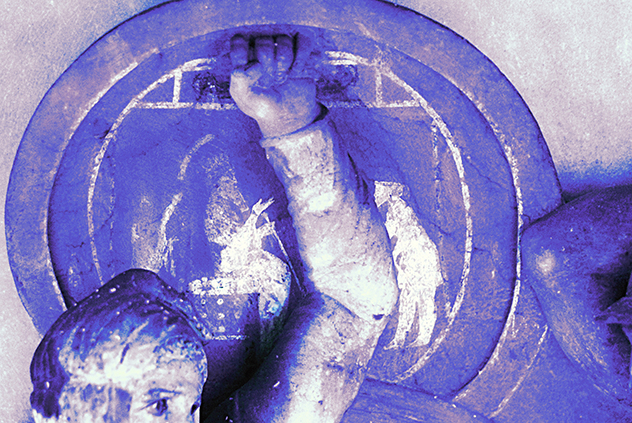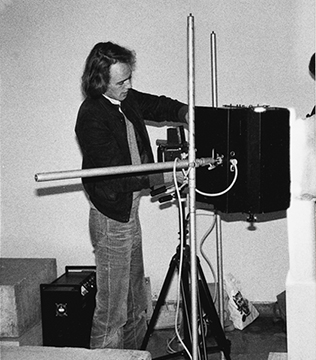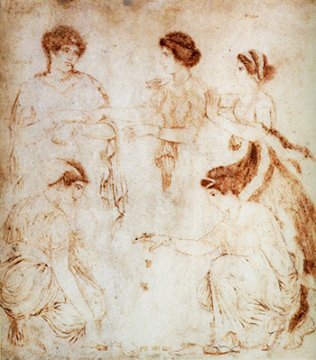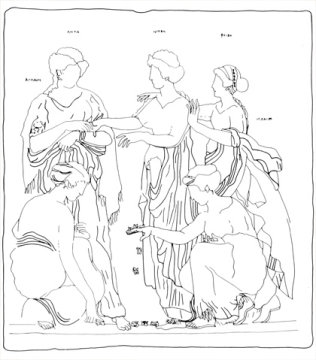The Painting Archive
Thanks to ancient authors such as Pliny or Pausanias, we know many names of ancient painters, the themes of their works, and their most characteristic handicrafts. Likewise, through them we learn which sculptors were valued for their work and, in rare cases, even which painters laid their hand to famous statues.
The study of ancient painting and the painting of antique sculptures however, remained disregarded for many centuries of research. The reason for this was due to the small number of surviving paintings and the poor state of preservation of the colour residues on the statues.

(Image by V. Brinkmann after H.-Chr. Wolters and V. v. Graeve) (Istanbul, Archaeological Museum, IN 370)
In 1966 Volkmar von Graeve, later professor at the University of Bochum, completed his doctorate on the Alexander Sarcophagus. Through the contacts and knowledge of his friend and fellow student Hans Christof Wolters, von Graeve extended the work into an investigation of the colours within the sarcophagus. Hans Christof Wolters’ uncle, Christian Wolters, a professional restorer at the Doerner-Institut in Munich, with the aid of long-term photographic UV images under a quartz lamp, made faded paint residues visible. Von Graeve and the young Wolters applied the technique to the Alexander Sarcophagus and found, next to high quality colouring, paintings on the insides of the shields, breastplates and horse blankets. The 1966 dissertation was followed by Volkmar von Graeve's 1976 habilitation treatise of the paintings on the grave steles of Demetrias.
In 1988, Volkmar von Graeve received his call to the Ruhr University. At Bochum he brought and continued working on numerous projects studying ancient painting. Important research areas included: Thessalian tombs, the grave steles of Alexandria, Pompeian murals, the marble paintings from Herculaneum and paintings of Macedonian tombs.

Over the years, von Graeve and Wolters, as well as their growing student body, continued to develop the investigation techniques.
Important for example, was Wolters idea of developing a strong flash system, which replaced the long exposure with the quartz lamp, thus bringing a faster work process and faster results.
In long campaigns, the researchers examined the traces of paint and paintings on numerous antique surfaces. They examined and photographed them with various light sources and meticulously documented their finds.
His students included Vinzenz Brinkmann (curator at the Liebieghaus Frankfurt and Apl. Professor at the Goethe University Frankfurt) and Ulrike Koch-Brinkmann (active at the universities of Augsburg, Göttingen and Tübingen). They are continuously developing the polychrome research of ancient sculptures and make their findings visible in plastic reconstructions. The latter travels the whole world in the extraordinarily successful exhibition "Colourful Gods". Richard Posamentir, professor at the Eberahrd-Karls University of Tübingen, is a pupil of von Graeves and published, in addition to his dissertation on the painted Attic grave stelae, a monograph on the polychromy of the grave steles from the Chersonesos.

Fig. 3: Marble picture from Herculaneum with the so-called knuckle players by the Athenian painter Alexandros (Neapel, Museo Archeologico Nazionale).
Figure taken from: I. Baldassarre — A. Rouveret — M. Salvadori — A. Pontrandolfo, Römische Malerei. Vom Hellenismus bis zur Spätantike (Köln 2002) 143.
The Painting Archive at the Bochum Institute houses the photo material of von Graeves campaigns. It was mainly recorded on Ektachromes, conserved in acid-free paper and acid-free cartons. In part, the footage is on small image slides. In addition, numerous drawings of paintings on grave steles and marble plates, made by von Graeve, are stored in the archive. Finally, the archive keeps the documentation of the photo campaigns and findings made by Graeves in the course of his investigations.
The Bochum Painting Archive is protected by a special climate control system.


